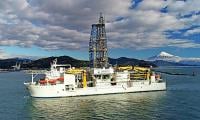Toxic air can damage child’s brain for good, says Unicef
LAHORE: The latest United Nations Children's Fund (Unicef) report has observed that air pollution can damage a child’s brain forever; and should Pakistan's health experts wish to pay heed to these most recent findings, this new study under review should certainly serve as a food for thought for both policy makers and inhabitants of a country, many parts of which are now regularly engulfed by a phenomenon called the "smog," which is a type of air pollution that is caused when smoke combines with fog.
While referring to this December 2017 Unicef report, the "Times of India" has stated: "The link between air pollution and respiratory diseases is well-established, but the United Nations Children’s Fund, in a report on Tuesday, said there is a growing body of scientific research which shows that air pollution canpermanently damage a child's brain.
The findings come at a time when India, particularly in the north, is facing a serious crisis due to rising levels of pollution. Last month, Delhi schools had to be shut temporarily to reduce children's exposure to pollutants that had enveloped the capital."
The top Indian newspaper maintained on December 6: "The Unicef report also said that South Asia had the largest proportion of babies living in areas where air pollution is at least six times higher than international limits (10 micrograms per cubic metre). The Unicef report, titled "Danger in the air", explains that brain damage can happen through several mechanisms. First, it stated, particulate matters can cause neuro-inflammation by damaging the blood-brain barrier — a thin, delicate membrane that protects the brain from toxic substances."
The "Times of India" has gone on to write: "Second, exposure to specific air pollutant particles, such as magnetite, can lead to oxidative stress which is often the cause of neurodegenerative diseases. Quoting multiple studies, the UN body said polycyclic aromatic hydrocarbons commonly found in areas of high automobile traffic contribute to a loss of or damage to white matter in the brain. White matter is important for continued learning and development. "Pollutants can permanently damage their developing brains," Unicef executive director Anthony Lake said. "The latest analysis of multiple researches states that pollutants can cross the placenta and affect the developing brain of a foetus (fetus)."
The Indian media house has further discussed the report: "A young child's brain is especially vulnerable because it can be damaged by a smaller dose of toxic chemicals. Children are also highly vulnerable to air pollution because their physical defences and immunities are 'not fully developed', UNICEF said. It advised parents to reduce children's exposure to pollutants by making it feasible for them to travel during times of the day when air pollution is lower."
AIR POLLUTION AND ITS EFFECTS IN PAKISTAN
According to the "New York Times," smog in Lahore during November 2017 had made levels of the dangerous particulates known as PM2.5, small enough to penetrate deep into the lungs and enter the bloodstream, reach 1,077 micrograms per cubic meter-- more than 30 times what Pakistan’s government considered the safe limit.
The November 10, 2017 report of the "New York Times" had held that in 2015, according to a World Health Organization estimate, almost 60,000 Pakistanis had perished from the high level of fine particles in the air, one of the world’s highest death tolls from air pollution.
Quoting a Pakistani meteorologist, the "USA Today" had also highlighted this grave issue and its adverse effects in November 2017:"Pollution, caused by dust, the burning of crops, and emissions from factories and brick kilns in Pakistan and neighbouring India, was expected to linger until the middle of the month. He advised people to wear face masks to protect themselves from respiratory ailments. Smog has enveloped much of Pakistan and neighboring India, causing highway accidents and respiratory problems, and forcing many residents to stay home."
SMOG AND INDIA
The American newspaper had viewed: "Similar problems have been reported in the Indian capital, New Delhi, where air quality was rated "very poor." India’s Supreme Court has banned the sale of firecrackers in New Delhi ahead of last month’s Hindu Diwali festival to try to curb air pollution in the notoriously smoggy city. Though reports said air quality was better than last year, pollution levels in the capital hit 18 times the healthy limit the night after the festival, as many dodged the ban."
HOW IS SMOG FORMED?
An "Al-Jazeera" Television report of November 5, 2017 had mentioned: "Smog results when photochemical reaction takes place between air pollutants from crop burning, vehicles and others sources, and sunlight and heat. The resulting thick haze - also known as ground level ozone - gets trapped near the earth due to warm air in atmosphere."
WHAT CAUSED SMOG IN INDIA AND PAKISTAN?
The afore-cited "Al-Jazeera" Television report had asserted: "The recent burning of crops in northern India, combined with fog, dust and air pollution from vehicles and factories, has resulted in a thick layer of smog covering several cities in India and Pakistan."
AROUND 300 MILLION WORLD CHILDREN BREATHE TOXIC AIR
In October 2016, UNICEF had pointed out that around 300 million children lived in areas where the air was toxic, exceeding international limits by at least six times!!
About 14 months ago, the UNICEF had stated: "Children are uniquely vulnerable to air pollution, breathing faster than adults on average and taking in more air relative to their body weight. The report also notes that air pollution is a major contributing factor in the deaths of around 0.6 million children under age 5 every year and threatens the health, lives and futures of millions more. It concludes with a set of concrete steps to take so that children can breathe clean, safe air."
AFP ADDS: Lead in paint alone causes brain damage in more than half-a-million children every year.
The UN Environment Assembly (UNEA) on Wednesday adopted a dozen pollution-curbing resolutions -- urging governments to ban the use of lead in paint, step up "actions" to prevent and significantly reduce marine pollution of all kinds by 2025, and urging member states to set ambitious air quality standards.
The president of the UNEA meeting, Costa Rica´s environment minister Edgar Gutierrez, lamented Wednesday that humans "haven´t done a good job" managing Earth´s natural bounty.
"The room we have for making more mistakes is very narrow," he warned. "Whilst leaders talk, the tide of plastic, chemicals and air pollution keeps growing," Greenpeace East Asia campaigner Cheng Qian said in a statement. "The decisions made here must be actioned, implemented and accelerated if we are to stand a chance of restoring the health of our planet."
-
 Prince Harry Breaks Cover In California Amid Tension At Home With Meghan Markle
Prince Harry Breaks Cover In California Amid Tension At Home With Meghan Markle -
 ASAP Rocky Makes Massive Comeback With New Album
ASAP Rocky Makes Massive Comeback With New Album -
 Amanda Seyfried Unveils How Channing Tatum Teased Her On 'Dear John' Set
Amanda Seyfried Unveils How Channing Tatum Teased Her On 'Dear John' Set -
 Blue Moon 2026: Everything You Need To Know
Blue Moon 2026: Everything You Need To Know -
 UN Warns Of 10-year Worst Hunger Crisis In Nigeria After Massive Aid Cuts
UN Warns Of 10-year Worst Hunger Crisis In Nigeria After Massive Aid Cuts -
 Dolly Parton Drops New Version Of Her 1977 Hit 'Light Of A Clear Blue Morning'
Dolly Parton Drops New Version Of Her 1977 Hit 'Light Of A Clear Blue Morning' -
 Redmi Note 15 Pro+5G Set For Global Rollout With Power-packed Features
Redmi Note 15 Pro+5G Set For Global Rollout With Power-packed Features -
 Meghan Markle Sparks Huge Tension With Harry At Home: 'At A Critical Crossroads'
Meghan Markle Sparks Huge Tension With Harry At Home: 'At A Critical Crossroads' -
 Insurrection Act Of 1807: All You Need To Know About Powerful US Emergency Law
Insurrection Act Of 1807: All You Need To Know About Powerful US Emergency Law -
 Philippines Blocks Elon Musk’s Grok AI
Philippines Blocks Elon Musk’s Grok AI -
 Jennifer Lawrence Blames Internet For Losing Sharon Tate Role
Jennifer Lawrence Blames Internet For Losing Sharon Tate Role -
 DeepMind, Google CEOs Sync Daily To Accelerate AI Race Against OpenAI
DeepMind, Google CEOs Sync Daily To Accelerate AI Race Against OpenAI -
 Japan Launches Probe Into 'Grok AI' Following Global Scrutiny Over 'inappropriate' Content
Japan Launches Probe Into 'Grok AI' Following Global Scrutiny Over 'inappropriate' Content -
 Prince Harry All Set To Return To Britain Next Week?
Prince Harry All Set To Return To Britain Next Week? -
 Is Princess Charlotte Becoming Most Confident Young Royal?
Is Princess Charlotte Becoming Most Confident Young Royal? -
 ‘Stranger Things’ Star David Harbour Speaks Up About ‘psychotherapy’
‘Stranger Things’ Star David Harbour Speaks Up About ‘psychotherapy’



